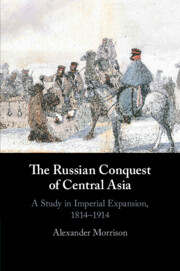Book contents
- The Russian Conquest of Central Asia
- The Russian Conquest of Central Asia
- Copyright page
- Dedication
- Contents
- Illustrations
- Maps
- Tables
- Acknowledgements
- Note on Translation, Transliteration and Dates
- Abbreviations
- Glossary
- Maps
- Introduction
- 1 Russia’s Steppe Frontier and the Napoleonic Generation
- 2 ‘Pray for the Camels’: The Winter Invasion of Khiva, 1839–41
- 3 ‘This Particularly Painful Place’: The Failure of the Syr-Darya Line as a Frontier, 1841–63
- 4 From Ayaguz to Almaty: The Conquest and Settlement of Semirechie, 1843–82
- 5 The Search for a ‘Natural’ Frontier and the Fall of Tashkent, 1863–5
- 6 War with Bukhara, 1866–8
- 7 The Fall of Khiva, 1872–3
- 8 ‘Those Who Should Be Spared’: The Conquest of Ferghana, 1875–6
- 9 ‘The Harder You Hit Them, the Longer They Will Be Quiet Afterwards’: The Conquest of Transcaspia, 1869–85
- 10 Aryanism on the Final Frontier of the Russian Empire: The Exploration and Annexation of the Pamirs, 1881–1905
- Epilogue: After the Conquest
- Sources and Bibliography
- Index
7 - The Fall of Khiva, 1872–3
Published online by Cambridge University Press: 19 November 2020
- The Russian Conquest of Central Asia
- The Russian Conquest of Central Asia
- Copyright page
- Dedication
- Contents
- Illustrations
- Maps
- Tables
- Acknowledgements
- Note on Translation, Transliteration and Dates
- Abbreviations
- Glossary
- Maps
- Introduction
- 1 Russia’s Steppe Frontier and the Napoleonic Generation
- 2 ‘Pray for the Camels’: The Winter Invasion of Khiva, 1839–41
- 3 ‘This Particularly Painful Place’: The Failure of the Syr-Darya Line as a Frontier, 1841–63
- 4 From Ayaguz to Almaty: The Conquest and Settlement of Semirechie, 1843–82
- 5 The Search for a ‘Natural’ Frontier and the Fall of Tashkent, 1863–5
- 6 War with Bukhara, 1866–8
- 7 The Fall of Khiva, 1872–3
- 8 ‘Those Who Should Be Spared’: The Conquest of Ferghana, 1875–6
- 9 ‘The Harder You Hit Them, the Longer They Will Be Quiet Afterwards’: The Conquest of Transcaspia, 1869–85
- 10 Aryanism on the Final Frontier of the Russian Empire: The Exploration and Annexation of the Pamirs, 1881–1905
- Epilogue: After the Conquest
- Sources and Bibliography
- Index
Summary
The Khanate of Khiva had a long history of cocking a snook at Russian authority. From the massacre of Bekovich-Cherkassky’s expedition in 1717 to the failure of Perovskii’s winter invasion in 1839–40, Khiva seemed the embodiment of ‘Asiatic insolence’ and intransigence. Turkestan Governor-General von Kaufman was determined to wipe out the memories of these early defeats and secure his own legacy as a great military leader. Easily securing consent from St Petersburg and brushing aside Khivan attempts to find a diplomatic solution, in 1873 he launched the most elaborate of all the Russian campaigns of conquest, with four different columns setting out from Krasnovodsk, Mangishlaq, Orenburg and Turkestan. Of these, the Krasnovodsk column ran out of water in the middle of the Qara-Qum desert and had to turn back. The Turkestan column, led by von Kaufman himself, almost met a similar fate in the Qizil-Qum, and was saved only by the skill of its Qazaq guides. Most of the fighting was done by the Orenburg and Manghishlaq columns, which reached the city of Khiva ahead of von Kaufman, who instructed them to wait until he arrived and could enter in triumph – with farcical consequences. The campaign ended on a grim note with the notorious massacre of the Yomud Turkmen by Russian forces, ostensibly designed to secure the internal authority of the Khivan Khan, Muhammad Rahim II, now a Russian puppet like his counterpart in Bukhara.
Keywords
- Type
- Chapter
- Information
- The Russian Conquest of Central AsiaA Study in Imperial Expansion, 1814–1914, pp. 307 - 373Publisher: Cambridge University PressPrint publication year: 2020

